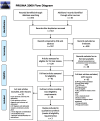The assessment of general movements in term and late-preterm infants diagnosed with neonatal encephalopathy, as a predictive tool of cerebral palsy by 2 years of age-a scoping review
- PMID: 34384482
- PMCID: PMC8359053
- DOI: 10.1186/s13643-021-01765-8
The assessment of general movements in term and late-preterm infants diagnosed with neonatal encephalopathy, as a predictive tool of cerebral palsy by 2 years of age-a scoping review
Abstract
Background: The General Movements Assessment is a non-invasive and cost-effective tool with demonstrated reliability for identifying infants at risk for cerebral palsy. Early detection of cerebral palsy allows for the implementation of early intervention and is associated with better functional outcomes. No review to date has summarized the utility of the General Movements Assessment to predict cerebral palsy in term and late-preterm infants diagnosed with neonatal encephalopathy.
Methods: We conducted a scoping review involving infants born greater than or equal to 34 weeks gestational age to identify all available evidence and delineate research gaps. We extracted data on sensitivity, specificity, and positive and negative predictive values and described the strengths and limitations of the results. We searched five databases (MEDLINE, Embase, PsychINFO, Scopus, and CINAHL) and the General Movements Trust website. Two reviewers conducted all screening and data extraction independently. The articles were categorized according to key findings, and a critical appraisal was performed.
Results: Only three studies, a cohort and two case series, met all of the inclusion criteria. The total number of participants was 118. None of the final eligible studies included late-preterm neonates. All three studies reported on sensitivity, specificity, and positive predictive and negative predictive values. An abnormal General Movement Assessment at 3-5 months has a high specificity (84.6-98%) for cerebral palsy with a similarly high negative predictive value (84.6-98%) when it was normal. Absent fidgety movements, in particular, are highly specific (96%) for moderate to severe cerebral palsy and carry a high negative predictive value (98%) when normal. In the time period between term and 4-5 months post-term, any cramped synchronized movements had results of 100% sensitivity and variable results for specificity, positive predictive value, and negative predictive value.
Conclusions: A normal General Movements Assessment at 3 months in a term high-risk infant is likely associated with a low risk for moderate/severe cerebral palsy. The finding of cramped synchronized General Movements is a strong predictor for the diagnosis of cerebral palsy by 2 years of age in the term population with neonatal encephalopathy. The deficit of high-quality research limits the applicability, and so the General Movements Assessment should not be used in isolation when assessing this population.
Systematic review registration: Title registration with Joanna Briggs Institute. URL: http://joannabriggswebdev.org/research/registered_titles.aspx .
Keywords: Cerebral palsy; General Movement Assessment; Hypoxia–ischemia encephalopathy; Infants; Motor development; Neonatal encephalopathy; Neonates; Prechtl; Preterm babies; Term babies.
© 2021. The Author(s).
Conflict of interest statement
The authors declare that they have no competing interests.
Figures
Similar articles
-
The general movements assessment in term and late-preterm infants diagnosed with neonatal encephalopathy, as a predictive tool of cerebral palsy by 2 years of age: a scoping review protocol.Syst Rev. 2020 Jul 4;9(1):154. doi: 10.1186/s13643-020-01358-x. Syst Rev. 2020. PMID: 32622366 Free PMC article.
-
The General Movements Assessment in Neonates With Hypoxic Ischemic Encephalopathy.J Child Neurol. 2021 Jul;36(8):601-609. doi: 10.1177/0883073820981515. Epub 2021 Jan 13. J Child Neurol. 2021. PMID: 33439066
-
Neonatal interventions for preventing cerebral palsy: an overview of Cochrane Systematic Reviews.Cochrane Database Syst Rev. 2018 Jun 20;6(6):CD012409. doi: 10.1002/14651858.CD012409.pub2. Cochrane Database Syst Rev. 2018. PMID: 29926474 Free PMC article.
-
Predictive validity of spontaneous early infant movement for later cerebral palsy: a systematic review.Dev Med Child Neurol. 2018 May;60(5):480-489. doi: 10.1111/dmcn.13697. Epub 2018 Feb 22. Dev Med Child Neurol. 2018. PMID: 29468662
-
Predictive value of assessment of general movements for neurological development of high-risk preterm infants: comparative study.Croat Med J. 2003 Dec;44(6):721-7. Croat Med J. 2003. PMID: 14652886
Cited by
-
Healthcare applications of single camera markerless motion capture: a scoping review.PeerJ. 2022 May 26;10:e13517. doi: 10.7717/peerj.13517. eCollection 2022. PeerJ. 2022. PMID: 35642200 Free PMC article.
-
The control of movement gradually transitions from feedback control to feedforward adaptation throughout childhood.NPJ Sci Learn. 2025 Mar 11;10(1):13. doi: 10.1038/s41539-025-00304-7. NPJ Sci Learn. 2025. PMID: 40069149 Free PMC article.
-
Automated Movement Analysis to Predict Cerebral Palsy in Very Preterm Infants: An Ambispective Cohort Study.Children (Basel). 2022 Jun 7;9(6):843. doi: 10.3390/children9060843. Children (Basel). 2022. PMID: 35740780 Free PMC article.
-
The General Movement Optimality Score-Revised (GMOS-R) with Socioeconomically Stratified Percentile Ranks.J Clin Med. 2024 Apr 13;13(8):2260. doi: 10.3390/jcm13082260. J Clin Med. 2024. PMID: 38673533 Free PMC article.
-
Clinical utility and psychometric properties of tools for early detection of developmental concerns and disability in young children: A scoping review.Dev Med Child Neurol. 2025 Mar;67(3):286-306. doi: 10.1111/dmcn.16076. Epub 2024 Sep 16. Dev Med Child Neurol. 2025. PMID: 39285306 Free PMC article.
References
-
- Rosenbaum P, Paneth N, Leviton A, Goldstein M, Bax M, Damiano D, et al. A report: the definition and classification of cerebral palsy April 2006. Dev Med Child Neurol Suppl. 2007;109(suppl 109):8–14. - PubMed
-
- American College of Obstetricians and Gynecologists. Neonatal Encephalopathy and Neurologic Outcome, Report of the American College of Obstetricians and Gynecologists’ Task Force on Neonatal Encephalopathy. Obstet Gynecol. 2014;123(4):896–901. - PubMed
Publication types
MeSH terms
LinkOut - more resources
Full Text Sources
Medical
Miscellaneous


